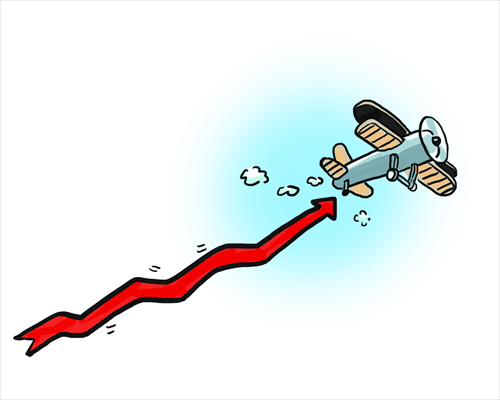HOME >> OP-ED
China bears arriving at rash conclusions
By Zheng Xiwen Source:Global Times Published: 2014-10-13 0:28:01

Illustration: Liu Rui/GT
China's economy now stands at a critical phase characterized by changing growth rates, restructuring and continuing utilization of previous stimulus. In other words, we are seeing a "new normal."
Some overseas observers suspicious about China have failed to grasp the import of these deep changes, instead talking down the Chinese economy by stating that its prospects are unclear.
They declare that the Chinese economy will continue to slow, with an extremely high risk of a hard landing. They hype claims that China's property market is going to collapse, saying that the risk of defaults in local government debt will trigger a chain reaction in China's finance sector. They also criticize the slow progress in China's reforms, predicting bleak prospects with the loss of China's "reform dividend."
As delusional as these views are, their bias and indiscretion is easily refuted.
First, too much focus on growth rates leads them to ignore the substance of China's economic transformation.
Compared to the double-digit growth rates of the past, last year's 7.7 percent and 7.4 percent during the first half this year do indicate a slowdown, but this is due to active measures taken by the government.
As Chinese President Xi Jinping has pointed out, it is not that we cannot achieve faster economic growth, but that we choose not to.
During the current minor slowdown, China has seen its labor productivity rise, making its industries and its economy as a whole more competitive globally.
This year, for the first time, the services sector surpassed the manufacturing in its share of economic activity, and consumption now takes up as much as 50 percent of GDP growth. These concrete results have been produced by higher quality and more efficient economic growth.
Germany, France and South Korea all saw slowdowns of 50 percent or more during their economic transitions. The average annual growth rate of Japan, averaged 9.7 percent from 1950 to 1972, fell to 0.86 percent between 1991 and 2012.
China's ability to maintain medium-rate growth during its restructuring period is rare indeed, foreshadowing bright prospects for the Chinese economy's sound and dynamic development.
Second, those observers simply employ existing theories without considering the special and complex features of Chinese economy. Those predicting unclear prospects for the Chinese economy are unlikely to be correct, since their predictions are based on so-called "international precedents," rather than an in-depth understanding of China's reality.
It's true that China's local governments are bearing a heavy debt burden, which is risky. But along with the debt comes a high saving rate among Chinese individuals and enterprises, and the steady long-term growth of the Chinese economy. Under such circumstance, local government debt is manageable.
Meanwhile, the debt funds the construction of useful assets, mainly infrastructure such as roads, airport links and energy projects, unlike consumer debt in the West. There won't be a debt crisis like what happened in Western countries if debt is properly handled in China.
China's real estate market is overheated, but it's nothing like the claims of Wall Street analysts who say that the bubbles in China's property market are far more serious than in Dubai.
Moreover, China's property market has built-in resistance to risks. Home buyers in China are required to put down 30 percent of the property's purchase price, while countries like the US require zero down payment in many cases.
China's household debt makes up less than 20 percent of GDP, far below 96 percent in the US and 62 percent in the eurozone.
A combination of increasing income of Chinese residents and urbanization will help the property market develop in a stable, healthy fashion.
Third, these shortsighted observers make light of the massive positive momentum produced by China's efforts to deepen reforms.
It's undeniable that problems have come into being after years of high-speed growth, some of which are deep, structural ones. But rather than shrinking from the challenge, the Chinese government has taken steps to boost markets through targeted measures.
In just a few months of this year, the Chinese government has introduced a series of reform measures that demonstrate its determination and strength.
These steps, targeted at the thorniest issues, will exert far-reaching and positive influence, helping the Chinese economy to continue its steady growth. With greater economic downward pressures, these steps serve as proof that China is better prepared to accelerate reform in the future.
It cannot be ruled out that some of the observers are money-driven, seeking to gin up false publicity. International speculators such as hedge funds and finance tycoons have long eyed China's nearly $4 trillion foreign exchange reserves. We should be extremely wary of the motives of anyone talking down the Chinese economy.
But these misguided views won't stop the progress of China's reform, nor will they reduce the attention paid to China by other countries.
As more and more countries have realized the huge dividends generated by China's deepening of reforms, China's major international cooperation initiatives have received widespread positive responses. This is a reflection of the international community's true opinion of China's economic prospects. A positive view is, in fact, the mainstream.
The author is a commentator of political affairs based in Beijing. opinion@globaltimes.com.cn
Posted in: Viewpoint